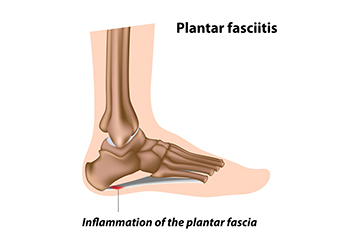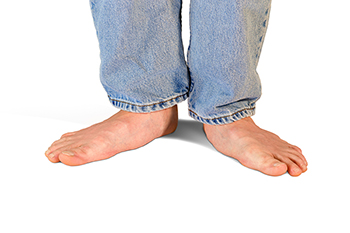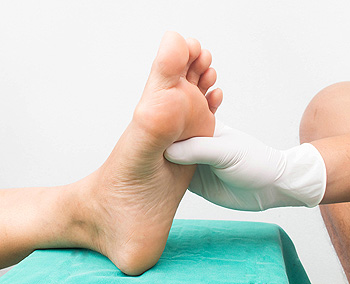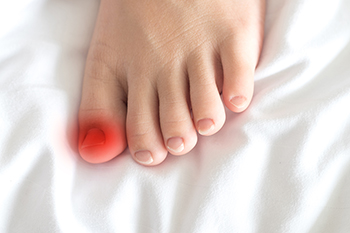Columbus: (614) 866-2477
Gahanna: (614) 939-9330
Lancaster: (740) 653-2656
Newark: (740) 344-8286
North Gahanna: (614) 478-2111
East Columbus: (614) 235-2323
Westerville: (614) 939-9330
Dublin: (614) 339-2000
Pickerington: (614) 545-4321
Lancaster: (740) 653-2656
Items filtered by date: June 2022
Treatment Options for Plantar Fasciitis

While a common cause of heel pain is plantar fasciitis, treatment options for relief may vary. Plantar fasciitis is an inflammation of the band of tissue on the sole of the foot that runs from the bottom of the toes to the heel. It is an overuse injury and is especially common among runners. With every step the plantar fascia contracts and then stretches, which can cause tiny tears in the tissue nearest the heel bone. The area then becomes inflamed and painful. Corticosteroid injections are a common treatment option for plantar fasciitis because they help to reduce the inflammation. However, steroids may also weaken the fatty pads under the heel, which in some cases results in chronic pain. A number of non-invasive treatments are thought to help reduce the effects of plantar fasciitis in those who do not respond to exercises and stretching. Among them are shock wave therapy and ultrasound therapy. If you have questions about treatment options, please consult a podiatrist for more information.
Plantar fasciitis can be very painful and inconvenient. If you are experiencing heel pain or symptoms of plantar fasciitis, contact one of our podiatrists from Foot & Ankle Specialists of Central Ohio. Our doctors can provide the care you need to keep you pain-free and on your feet.
What Is Plantar Fasciitis?
Plantar fasciitis is the inflammation of the thick band of tissue that runs along the bottom of your foot, known as the plantar fascia, and causes mild to severe heel pain.
What Causes Plantar Fasciitis?
- Excessive running
- Non-supportive shoes
- Overpronation
- Repeated stretching and tearing of the plantar fascia
How Can It Be Treated?
- Conservative measures – anti-inflammatories, ice packs, stretching exercises, physical therapy, orthotic devices
- Shockwave therapy – sound waves are sent to the affected area to facilitate healing and are usually used for chronic cases of plantar fasciitis
- Surgery – usually only used as a last resort when all else fails. The plantar fascia can be surgically detached from the heel
While very treatable, plantar fasciitis is definitely not something that should be ignored. Especially in severe cases, speaking to your doctor right away is highly recommended to avoid complications and severe heel pain. Your podiatrist can work with you to provide the appropriate treatment options tailored to your condition.
If you have any questions please feel free to contact our offices located in Gahanna, Newark, Columbus, and Lancaster, OH . We offer the newest diagnostic and treatment technologies for all your foot and ankle needs.
Flat Foot Exercises

Fallen arches are another name for flat feet. It is noticed while standing and the entire foot lies flat on the ground. Many people have genetic traits for this condition and some people experience discomfort with it. The arch plays a crucial role in maintaining balance in the body and may be improved by performing specific exercises. A towel scrunch is done by sitting on a chair and putting a towel on the floor by your feet. This is followed by grabbing the towel with the muscles in the feet. This is repeated several times and completed with the other foot too. An effective foot and arch stretch is referred to as stair heel raises. This is accomplished by standing on a step and lowering the heel until a gentle stretch is felt. A toe extension can benefit the muscles in the top of the foot that helps to control the toes. This is achieved by pushing on the toes with the fingers and holding for several seconds. If you would like to know more information about flat foot exercises, please confer with a podiatrist.
Flatfoot is a condition many people suffer from. If you have flat feet, contact one of our podiatrists from Foot & Ankle Specialists of Central Ohio. Our doctors will treat your foot and ankle needs.
What Are Flat Feet?
Flatfoot is a condition in which the arch of the foot is depressed and the sole of the foot is almost completely in contact with the ground. About 20-30% of the population generally has flat feet because their arches never formed during growth.
Conditions & Problems:
Having flat feet makes it difficult to run or walk because of the stress placed on the ankles.
Alignment – The general alignment of your legs can be disrupted, because the ankles move inward which can cause major discomfort.
Knees – If you have complications with your knees, flat feet can be a contributor to arthritis in that area.
Symptoms
- Pain around the heel or arch area
- Trouble standing on the tip toe
- Swelling around the inside of the ankle
- Flat look to one or both feet
- Having your shoes feel uneven when worn
Treatment
If you are experiencing pain and stress on the foot you may weaken the posterior tibial tendon, which runs around the inside of the ankle.
If you have any questions please feel free to contact our offices located in Gahanna, Newark, Columbus, and Lancaster, OH . We offer the newest diagnostic and treatment technologies for all your foot and ankle needs.
Flat Foot Exercises

Fallen arches are another name for flat feet. It is noticed while standing and the entire foot lies flat on the ground. Many people have genetic traits for this condition and some people experience discomfort with it. The arch plays a crucial role in maintaining balance in the body and may be improved by performing specific exercises. A towel scrunch is done by sitting on a chair and putting a towel on the floor by your feet. This is followed by grabbing the towel with the muscles in the feet. This is repeated several times and completed with the other foot too. An effective foot and arch stretch is referred to as stair heel raises. This is accomplished by standing on a step and lowering the heel until a gentle stretch is felt. A toe extension can benefit the muscles in the top of the foot that helps to control the toes. This is achieved by pushing on the toes with the fingers and holding for several seconds. If you would like to know more information about flat foot exercises, please confer with a podiatrist.
Flatfoot is a condition many people suffer from. If you have flat feet, contact one of our podiatrists from Foot & Ankle Specialists of Central Ohio. Our doctors will treat your foot and ankle needs.
What Are Flat Feet?
Flatfoot is a condition in which the arch of the foot is depressed and the sole of the foot is almost completely in contact with the ground. About 20-30% of the population generally has flat feet because their arches never formed during growth.
Conditions & Problems:
Having flat feet makes it difficult to run or walk because of the stress placed on the ankles.
Alignment – The general alignment of your legs can be disrupted, because the ankles move inward which can cause major discomfort.
Knees – If you have complications with your knees, flat feet can be a contributor to arthritis in that area.
Symptoms
- Pain around the heel or arch area
- Trouble standing on the tip toe
- Swelling around the inside of the ankle
- Flat look to one or both feet
- Having your shoes feel uneven when worn
Treatment
If you are experiencing pain and stress on the foot you may weaken the posterior tibial tendon, which runs around the inside of the ankle.
If you have any questions please feel free to contact our offices located in Gahanna, Newark, Columbus, and Lancaster, OH . We offer the newest diagnostic and treatment technologies for all your foot and ankle needs.
Do You Suffer From Painful Feet?
Do You Suffer From Painful Feet?
What is Diabetic Neuropathy?

Many people who have had diabetes for a long time may also have a condition known as diabetic neuropathy. The most common form is peripheral neuropathy, which in diabetics usually affects the feet. Symptoms include numbness, reduced ability to feel pain or temperature changes, and tingling or burning sensations. Sharp pains or cramps may also occur. These can further evolve into foot ulcers (wounds that do not heal properly) and infections from cracks or sores in the skin. If ignored or left untreated, gangrene may develop which could lead to surgery or amputation. The main causes of peripheral neuropathy are high levels of sugar and triglycerides in the blood which can damage the nerves and blood vessels in the feet. Since the symptoms of peripheral neuropathy develop over time, it is easy to overlook this condition. Daily foot care is imperative to maintain healthy feet. Another important way to prevent or handle diabetic neuropathy is to schedule regular visits to a podiatrist who can monitor the condition of your feet and treat them accordingly.
Neuropathy
Neuropathy can be a potentially serious condition, especially if it is left undiagnosed. If you have any concerns that you may be experiencing nerve loss in your feet, consult with one of our podiatrists from Foot & Ankle Specialists of Central Ohio. Our doctors will assess your condition and provide you with quality foot and ankle treatment for neuropathy.
What Is Neuropathy?
Neuropathy is a condition that leads to damage to the nerves in the body. Peripheral neuropathy, or neuropathy that affects your peripheral nervous system, usually occurs in the feet. Neuropathy can be triggered by a number of different causes. Such causes include diabetes, infections, cancers, disorders, and toxic substances.
Symptoms of Neuropathy Include:
- Numbness
- Sensation loss
- Prickling and tingling sensations
- Throbbing, freezing, burning pains
- Muscle weakness
Those with diabetes are at serious risk due to being unable to feel an ulcer on their feet. Diabetics usually also suffer from poor blood circulation. This can lead to the wound not healing, infections occurring, and the limb may have to be amputated.
Treatment
To treat neuropathy in the foot, podiatrists will first diagnose the cause of the neuropathy. Figuring out the underlying cause of the neuropathy will allow the podiatrist to prescribe the best treatment, whether it be caused by diabetes, toxic substance exposure, infection, etc. If the nerve has not died, then it’s possible that sensation may be able to return to the foot.
Pain medication may be issued for pain. Electrical nerve stimulation can be used to stimulate nerves. If the neuropathy is caused from pressure on the nerves, then surgery may be necessary.
If you have any questions, please feel free to contact our offices located in Gahanna, Newark, Columbus, and Lancaster, OH . We offer the newest diagnostic and treatment technologies for all your foot care needs.
What is Diabetic Neuropathy?

Many people who have had diabetes for a long time may also have a condition known as diabetic neuropathy. The most common form is peripheral neuropathy, which in diabetics usually affects the feet. Symptoms include numbness, reduced ability to feel pain or temperature changes, and tingling or burning sensations. Sharp pains or cramps may also occur. These can further evolve into foot ulcers (wounds that do not heal properly) and infections from cracks or sores in the skin. If ignored or left untreated, gangrene may develop which could lead to surgery or amputation. The main causes of peripheral neuropathy are high levels of sugar and triglycerides in the blood which can damage the nerves and blood vessels in the feet. Since the symptoms of peripheral neuropathy develop over time, it is easy to overlook this condition. Daily foot care is imperative to maintain healthy feet. Another important way to prevent or handle diabetic neuropathy is to schedule regular visits to a podiatrist who can monitor the condition of your feet and treat them accordingly.
Neuropathy
Neuropathy can be a potentially serious condition, especially if it is left undiagnosed. If you have any concerns that you may be experiencing nerve loss in your feet, consult with one of our podiatrists from Foot & Ankle Specialists of Central Ohio. Our doctors will assess your condition and provide you with quality foot and ankle treatment for neuropathy.
What Is Neuropathy?
Neuropathy is a condition that leads to damage to the nerves in the body. Peripheral neuropathy, or neuropathy that affects your peripheral nervous system, usually occurs in the feet. Neuropathy can be triggered by a number of different causes. Such causes include diabetes, infections, cancers, disorders, and toxic substances.
Symptoms of Neuropathy Include:
- Numbness
- Sensation loss
- Prickling and tingling sensations
- Throbbing, freezing, burning pains
- Muscle weakness
Those with diabetes are at serious risk due to being unable to feel an ulcer on their feet. Diabetics usually also suffer from poor blood circulation. This can lead to the wound not healing, infections occurring, and the limb may have to be amputated.
Treatment
To treat neuropathy in the foot, podiatrists will first diagnose the cause of the neuropathy. Figuring out the underlying cause of the neuropathy will allow the podiatrist to prescribe the best treatment, whether it be caused by diabetes, toxic substance exposure, infection, etc. If the nerve has not died, then it’s possible that sensation may be able to return to the foot.
Pain medication may be issued for pain. Electrical nerve stimulation can be used to stimulate nerves. If the neuropathy is caused from pressure on the nerves, then surgery may be necessary.
If you have any questions, please feel free to contact our offices located in Gahanna, Newark, Columbus, and Lancaster, OH . We offer the newest diagnostic and treatment technologies for all your foot care needs.
How Do Ingrown Toenails Develop?

The medical term for an ingrown toenail is onychocryptosis. It can cause pain and discomfort from the nail growing into the sides of the skin. It is a common foot condition that can be caused by wearing shoes that do not fit correctly. Additionally, many people develop ingrown toenails from genetic factors or from trimming the toenails incorrectly. The symptoms that are often observed with ingrown toenails are toe pain, redness, and a discharge may ooze from the affected area. The foot may feel better when it is soaked in warm water, and this can help to soften the skin. In mild cases, the ingrown toenail can be pushed away from the skin, which may accelerate healing. If you have developed an ingrown toenail and, especially if you have medical conditions that can include diabetes or neuropathy, it is strongly advised that you seek the counsel of a podiatrist who can provide the care needed.
Ingrown toenails can become painful if they are not treated properly. For more information about ingrown toenails, contact one of our podiatrists of Foot & Ankle Specialists of Central Ohio. Our doctors can provide the care you need to keep you pain-free and on your feet.
Ingrown Toenails
Ingrown toenails occur when a toenail grows sideways into the bed of the nail, causing pain, swelling, and possibly infection.
Causes
- Bacterial infections
- Improper nail cutting such as cutting it too short or not straight across
- Trauma to the toe, such as stubbing, which causes the nail to grow back irregularly
- Ill-fitting shoes that bunch the toes too close together
- Genetic predisposition
Prevention
Because ingrown toenails are not something found outside of shoe-wearing cultures, going barefoot as often as possible will decrease the likeliness of developing ingrown toenails. Wearing proper fitting shoes and using proper cutting techniques will also help decrease your risk of developing ingrown toenails.
Treatment
Ingrown toenails are a very treatable foot condition. In minor cases, soaking the affected area in salt or antibacterial soaps will not only help with the ingrown nail itself, but also help prevent any infections from occurring. In more severe cases, surgery is an option. In either case, speaking to your podiatrist about this condition will help you get a better understanding of specific treatment options that are right for you.
If you have any questions please feel free to contact our offices located in Gahanna, Newark, Columbus, and Lancaster, OH . We offer the newest diagnostic and treatment technologies for all your foot and ankle needs.
How Do Ingrown Toenails Develop?

The medical term for an ingrown toenail is onychocryptosis. It can cause pain and discomfort from the nail growing into the sides of the skin. It is a common foot condition that can be caused by wearing shoes that do not fit correctly. Additionally, many people develop ingrown toenails from genetic factors or from trimming the toenails incorrectly. The symptoms that are often observed with ingrown toenails are toe pain, redness, and a discharge may ooze from the affected area. The foot may feel better when it is soaked in warm water, and this can help to soften the skin. In mild cases, the ingrown toenail can be pushed away from the skin, which may accelerate healing. If you have developed an ingrown toenail and, especially if you have medical conditions that can include diabetes or neuropathy, it is strongly advised that you seek the counsel of a podiatrist who can provide the care needed.
Ingrown toenails can become painful if they are not treated properly. For more information about ingrown toenails, contact one of our podiatrists of Foot & Ankle Specialists of Central Ohio. Our doctors can provide the care you need to keep you pain-free and on your feet.
Ingrown Toenails
Ingrown toenails occur when a toenail grows sideways into the bed of the nail, causing pain, swelling, and possibly infection.
Causes
- Bacterial infections
- Improper nail cutting such as cutting it too short or not straight across
- Trauma to the toe, such as stubbing, which causes the nail to grow back irregularly
- Ill-fitting shoes that bunch the toes too close together
- Genetic predisposition
Prevention
Because ingrown toenails are not something found outside of shoe-wearing cultures, going barefoot as often as possible will decrease the likeliness of developing ingrown toenails. Wearing proper fitting shoes and using proper cutting techniques will also help decrease your risk of developing ingrown toenails.
Treatment
Ingrown toenails are a very treatable foot condition. In minor cases, soaking the affected area in salt or antibacterial soaps will not only help with the ingrown nail itself, but also help prevent any infections from occurring. In more severe cases, surgery is an option. In either case, speaking to your podiatrist about this condition will help you get a better understanding of specific treatment options that are right for you.
If you have any questions please feel free to contact our offices located in Gahanna, Newark, Columbus, and Lancaster, OH . We offer the newest diagnostic and treatment technologies for all your foot and ankle needs.
Heel Pain Relief with Custom Orthotics

One of the top reasons why patients come in to Foot and Ankle Specialists of Central Ohio is because they are experiencing some kind of heel pain. Some experience it first thing when they wake up. Others experience it gradually worsening throughout the day. Some only experience it after engaging in exercise. No matter what the severity is, patients with heel pain deserve relief.
One way to achieve this is through custom orthotics.
What are custom orthotics?
Orthotics are shoe inserts that are custom molded to your unique feet so that they can correct any abnormal foot function or provide extra padding or support where needed. While functional orthotics address foot mechanics, accommodative orthotics address comfort, especially if you have underlying conditions like diabetes, bunions, or arthritis.
What benefits do they provide?
Unlike over the counter orthotics that you may see at a pharmacy, custom orthotics are created for your individual feet and can therefore target your heel pain. And as a result, the benefits they provide are further enhanced:
- Prevent injuries
- Prevent worsening of foot conditions like bunions, hammertoes, and flat feet.
- Provide arch support and relief
- Correct abnormal foot mechanics
- Provide ankle stability
- Ease pain
- Enhance comfort when wearing shoes
- Improve how you walk
- Minimize risk of needing more invasive treatments
Get help from our foot doctors!
Our podiatrists may prescribe custom orthotics as a first step in treatment for heel pain because it can sometimes be sufficient in alleviating your pain. In addition to creating custom orthotics, make sure that your shoes are properly-fitting and supportive. Choosing shoes made with breathable material, with a wide toe box with enough room for your toes to wiggle, arch and heel support for ample shock absorption, and a snug-fitting heel are all important features to look for.
At Foot and Ankle Specialists of Central Ohio, our team of foot care specialists are dedicated to providing high-quality care with care and compassion. They treat a wide range of podiatric conditions, including plantar fasciitis, foot deformities, skin issues, nail fungus, and diabetes-related problems. Wondering if you can benefit from custom orthotics to relieve your heel pain? Schedule an appointment by contacting any of our offices in Gahanna, Newark, and Columbus, OH today!
Blog Archives
- April 2024
- March 2024
- February 2024
- January 2024
- December 2023
- November 2023
- October 2023
- September 2023
- August 2023
- July 2023
- June 2023
- May 2023
- April 2023
- March 2023
- February 2023
- January 2023
- December 2022
- November 2022
- October 2022
- September 2022
- August 2022
- July 2022
- June 2022
- May 2022
- April 2022
- March 2022
- February 2022
- January 2022
- December 2021
- November 2021
- October 2021
- September 2021
- August 2021
- July 2021
- June 2021
- May 2021
- April 2021
- March 2021
- February 2021
- January 2021
- December 2020
- November 2020
- October 2020
- September 2020
- August 2020
- July 2020
- June 2020
- May 2020
- April 2020
- March 2020
- February 2020
- January 2020
- December 2019
- November 2019
- October 2019
- September 2019
- August 2019
- July 2019


